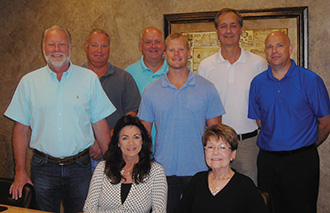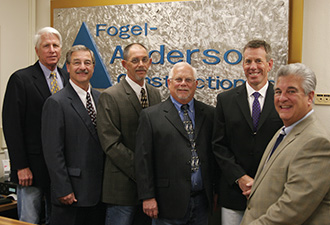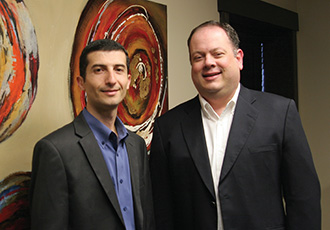
( l-r): Rob Thomson, Executive Vice President, Communications & Digital;
Shawn Quesnell, Controller; Jake Reid, Chief Revenue Officer; Greg Cotton, General Counsel & Chief of Staff.
NUMBER SIX:
SPORTING KANSAS CITY
1st Year
Gross Revenue:
2013: $24,000,000
2010: $3,500,000
Growth: 585.71%
Full-time employees: 103
Take note: The success of Sporting Kansas City is based on growth through 2013—before the nation sat up and took note of its soccer prowess with the FIFA world championship tournament in Brazil earlier this month. The U.S. team’s performance there will do little to dampen interest in the sport, where Kansas City’s professional franchise has carved out a reputation not just for on-field excellence, but for creating one of the best fan experiences available in any sport. Attendance continues to rise at Sporting Park, the $200 million, state-of-the-art stadium in western Wyandotte County’s Village West development, and it’s likely to surge even more this year—Sporting took home major-league soccer’s championship, the MLS Cup, with a 7-6 decision on penalties after a 1-1 regular-session tie with Real Salt Lake last December. Robb Heineman is the CEO of the club, purchased from the late Lamar Hunt by a group that included Heineman, Pat Curran and Greg Maday, and Cerner co-founders Cliff Illig and Neal Patterson.

Standing, (l-r): Jim Lambie, President; Brad Pedersen, Project Manager; Tim Hovey, Vice President; Steve Lambie, Project Manager; Brad Harder, Project Manager; James Dunster, Estimator. Seated, (l-r): Diane Lambie, Accounting Administrator; Diane Lindemann, Contract Coordinator. Not pictured: Teri Chrislip, Office Admin.
NUMBER SEVEN:
LAMBIE CUSTOM HOMES
1st Year
Gross Revenue:
2013: $17,403,1174
2010: $2,696,802
Growth: 545.32%
Full-time employees: 9
Jim Lambie didn’t wait to get out of college to start his company:
He founded Lambie Custom Homes in 1978, when he was still a student at Kanas State. “I felt that there was a great opportunity in the Kansas City market place for new homes,” he recalls, and with a little help from the legendary banker Frank Morgan, Lambie secured his first business loan. “I started the company with one speculative home, which I did all the trim myself,” he says. “I trimmed for two other builders at the time and also did remodeling.” But the first home sold quickly, he pre-sold several others and soon, “word of mouth and referrals quickly grew.” After weathering the construction downturn that set in after 2009, Lambie was poised to capture business in the niche for high-quality homes. Now, he’s looking at the way demographics are driving changes in the business to stoke the next growth phase: “There is a large demand for affordable housing and move-down or ‘right sizing’ and maintenance-free homes,” he says. “We also have seen a demand for handicap-accessible homes, which are hard to find.”

(l-r): Norman Haas, Owner; Amanda Covey, Consumer Services Manager; Joe McCarthy, General Manager; Jen Geis, Marketing Manager.
NUMBER EIGHT:
FOODLINKS
1st Year
Gross Revenue:
2013: $9,483,724
2010: $1,709,662
Growth: 454.71%
Full-time employees: 7
The issues connected to what Norman Haas calls hyper-growth—not all of which are a joy to deal with—have created in him something of an insatiable appetite. Which may be a good thing, considering his line of work. Nearly a quarter-century ago, in the 1991 Corporate Report 100, Haas first graced this lineup as CEO of a company called Continental Food Corp., and kept it there through 1993, later selling that concern.
And yet, here he is again, as owner of FoodLinks, Inc., the premium food ingredient importer and wholesaler he founded in 2001. FoodLinks has carved out a niche importing and distributing super premium chocolate products from Colombia, Belgium and France. Trust us: You haven’t really experienced a Pavlovian level of drool until you visit the company’s Web site. “Growing at the pace we do seems awesome, but it presents challenges that are unique to hyper growth,” Haas concedes. “But it’s in my DNA to keep going after new businesses.”

(l-r): Tom Dunn, Executive VP; Jeff Bartolotta, Corporate Secretary;
Sheldon Simmeron, Director-Field Operations; Jim Belt, Senior Estimator; Greg Harrelson, Senior Estimator; Phil Bartolotta, Owner.
NUMBER NINE:
FOGEL-ANDERSON CONSTRUCTION
1st Year
Gross Revenue:
2013: $32,462,250
2010: $6,020,561
Growth: 439.19%
Full-time employees: 30
Sometimes, you don’t see the knitted-sweater effects of an economy until you start pulling one thread out—and things can get complicated. So when consumer buying patterns started changing with the advent of on-line purchasing, one connecting thread was retail construction. And for a company like Fogel-Anderson Construction Co., that meant pivoting to seize opportunities to diversify its workload. “Everybody in this business has their own little niche,” said Phil Bartolotta, the contracting company’s president. “We kind of changed ours from 80 percent retail to 20 percent, because the retail market slowed so much. We moved from larger retail work and private work to more public work. The retail big-box stores, except for Walmart—nobody is building.” That move has positioned the company for growth in other project types—educational settings, for one. While the improved economy has had a lot to do with the company’s fortunes, “we tightened up and had more opportunities, and with more opportunities comes growth,” Bartolotta said. “We’re hiring more people, and more estimators to bid more work.”

(l-r): Zalman Kohen, Senior Vice President/Chief Operating Officer; Fred Delibero, President/CEO.
NUMBER TEN:
SUMMIT CUSTOM HOMES
3rd Year
Gross Revenue:
2013: $64,140,287
2010: $12,779,667
Growth: 401.89%
Full-time employees: 32
Fred Delibero saw it coming: “In 2006, we quickly realized that the residential real-estate market was in trouble.” So his team at Summit Custom Homes retooled its plan offerings, focusing more on two-story homes designed for young, upwardly mobile families. “They’re always in the market, even in a downturn, because of life changes including marriage, a new baby, a new job, or a promotion,” he said. And the instincts proved correct, propelling Summit into the CR100 fold last year at No. 11 with 280 percent growth, and into the last Top 10 slot this year at nearly 402 percent. Other keys he cited were ample capitalization, recognition of an emerging market with energy-efficient homes, and an increase in marketing efforts and brand-building. Understanding lenders was helpful, he said, but “along the way, we also became a land investor and developer. We bought a number of distressed, bank-owned single family subdivisions and quickly repositioned them into thriving communities. Later on, we began buying ground and developing our own lots in communities where people want to live, complete with playgrounds, walking trails, pools and other amenities.”